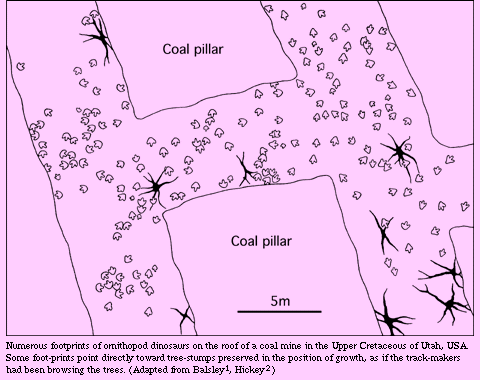
|

|
|
It is common to find tracks of two or more dinosaurs at a single site. Such natural associations may be monotypic, comprising footprints of a single type, or polytypic, involving several ichnotaxa. In some cases there are only a few trackways, but in others there may be dozens or even hun-dreds, and occasionally a site is so thor-oughly trampled and churned by the feet of dinosaurs that it is impossible to distinguish the individual footprints. This dinosaurian trampling of the substrate, which has been termed dinoturbation (Dodson et al.)3, sometimes provokes wry comments from palaeontologists. A site trodden by Cretaceous brontosaurs re-sem-bled a 'sauropodian barnyard where a wallowing good time was had by all' (Roland T. Bird, quoted by Farlow)4, and S.P. Welles5 described a much trampled area in the Kayenta Formation of Arizona as: ... a 'chicken yard' hodge-podge of footprints, few of which can be identified as belonging to a trackway ... a single trackway shows about 10 footprints in a row heading west-the only animal that seemed to know where he was going! Many sites show dinosaur tracks distributed at random. Sometimes the tracks are uniform in morphology, representing a single ichnospecies or perhaps even a single species of dinosaur, but in other instances they are heterogeneous and clearly originated from several different sorts of dinosaurs. Some of these occurrences really do seem to be random accumulations, formed when dinosaurs traversed an area by chance, either individually or in groups. But occasionally there is an obvious reason for a local concentration of footprints. An interesting occurrence was reported by J.K. Balsley6 from the roof of a coal mine in Utah (see diagram). Numerous footprint casts of late cretaceous ornithopods were preserved on the roof of the coal workings, scattered among tree stumps preserved in their position of growth. It is noteworthy that some footprints 'occur around the bases of the trees and are pointed inward as though the animals were browsing on the standing vegetation'. ___________1. Balsley, J K., 1980. Cretaceous Wave-dominated Delta systems:
Book Cliffs, East-central Utah. American Association of Petroleum Geologists,
Continuing Education Department, Tulsa; p. 133 |